Tuesday Sept. 25 Walking Tour of Copenhagen
“I thought everything in Denmark was either smoked, pickled or marinated!"
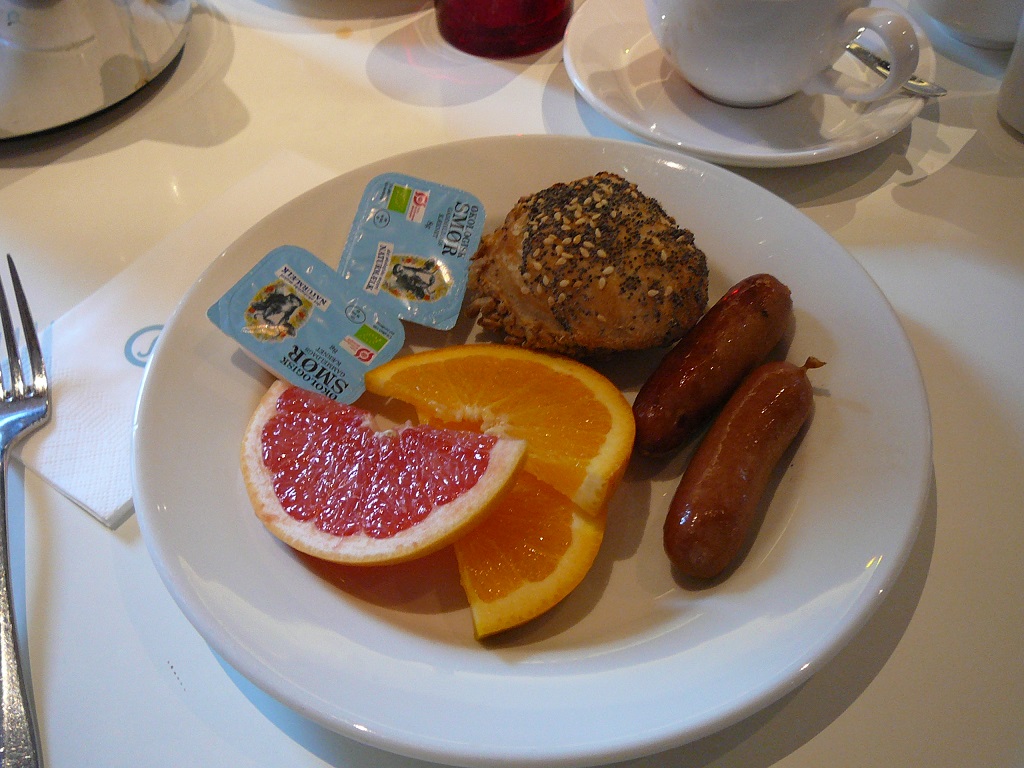
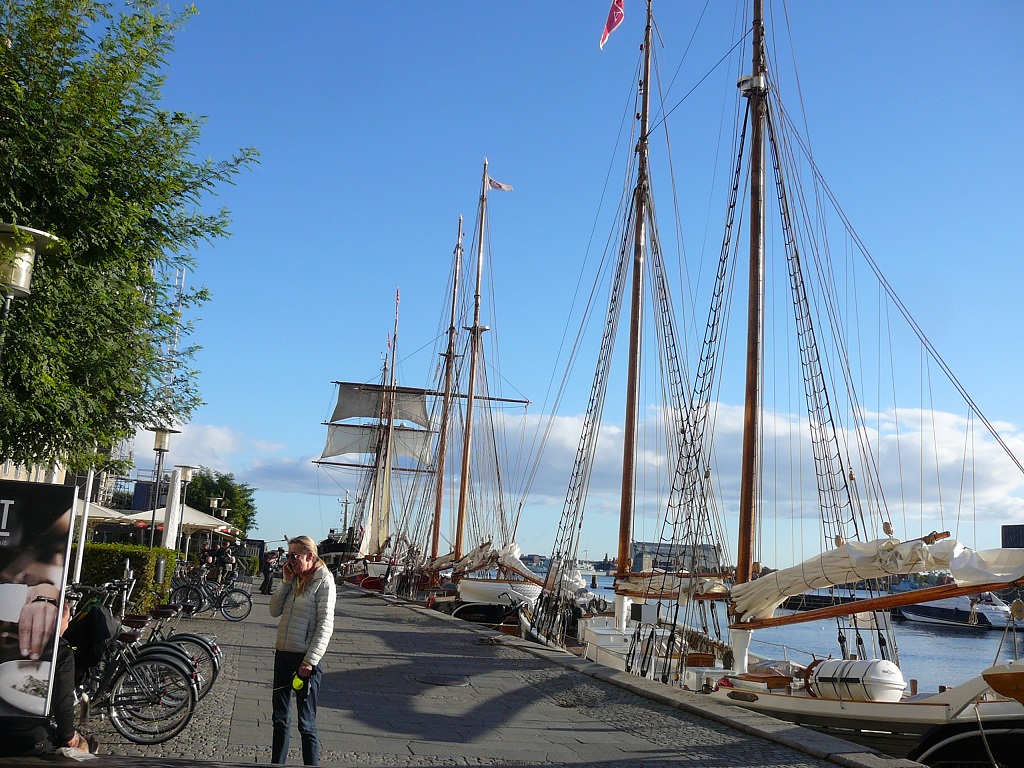 Oh joy of joys! Our window faces east, and the sun rises brightly and shines into our room. We will have a good day to walk the city streets. Outside our windows we gaze down on the old sailing vessels lining the inner river. After breakfast Al and I stroll up and down admiring the “Lilla Dan” of Kobenhavn, the “Halmo” of Svenborg, Denmark and the “Mira” of Kobenhavn.
Oh joy of joys! Our window faces east, and the sun rises brightly and shines into our room. We will have a good day to walk the city streets. Outside our windows we gaze down on the old sailing vessels lining the inner river. After breakfast Al and I stroll up and down admiring the “Lilla Dan” of Kobenhavn, the “Halmo” of Svenborg, Denmark and the “Mira” of Kobenhavn.
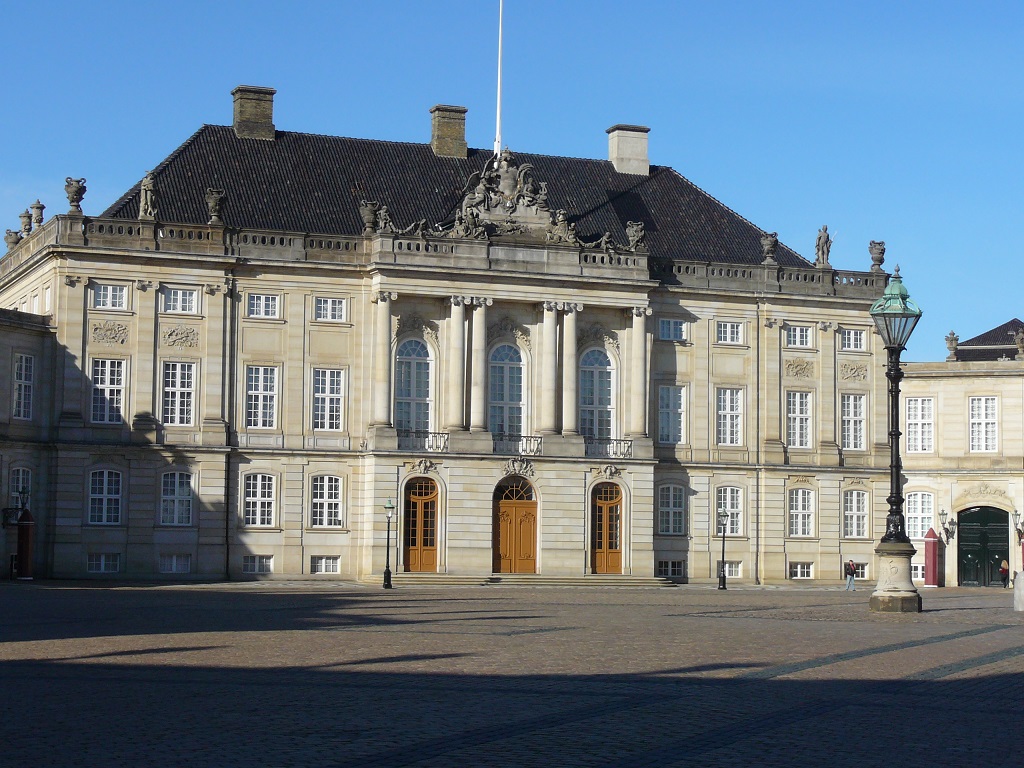
 Continuing our walk we enter the grounds of Amlienborg Palace walking past the flowing fountains. We are just in time for the changing of the guard. The palace complex is the Danish royal’s winter home. Entering the main courtyard Al and I are facing four identical palaces. We gaze in wonder at the beautiful buildings as the royal guards march in precision moving from one palace building to another. They are dressed in navy blue jackets with blue trousers. Parts of the living quarters are now open to the public and include the private rooms of previous royal families, paintings and all manner of family collections. On our way out of the courtyard we pass by the tall statue of King Frederik V (1771).
Continuing our walk we enter the grounds of Amlienborg Palace walking past the flowing fountains. We are just in time for the changing of the guard. The palace complex is the Danish royal’s winter home. Entering the main courtyard Al and I are facing four identical palaces. We gaze in wonder at the beautiful buildings as the royal guards march in precision moving from one palace building to another. They are dressed in navy blue jackets with blue trousers. Parts of the living quarters are now open to the public and include the private rooms of previous royal families, paintings and all manner of family collections. On our way out of the courtyard we pass by the tall statue of King Frederik V (1771).

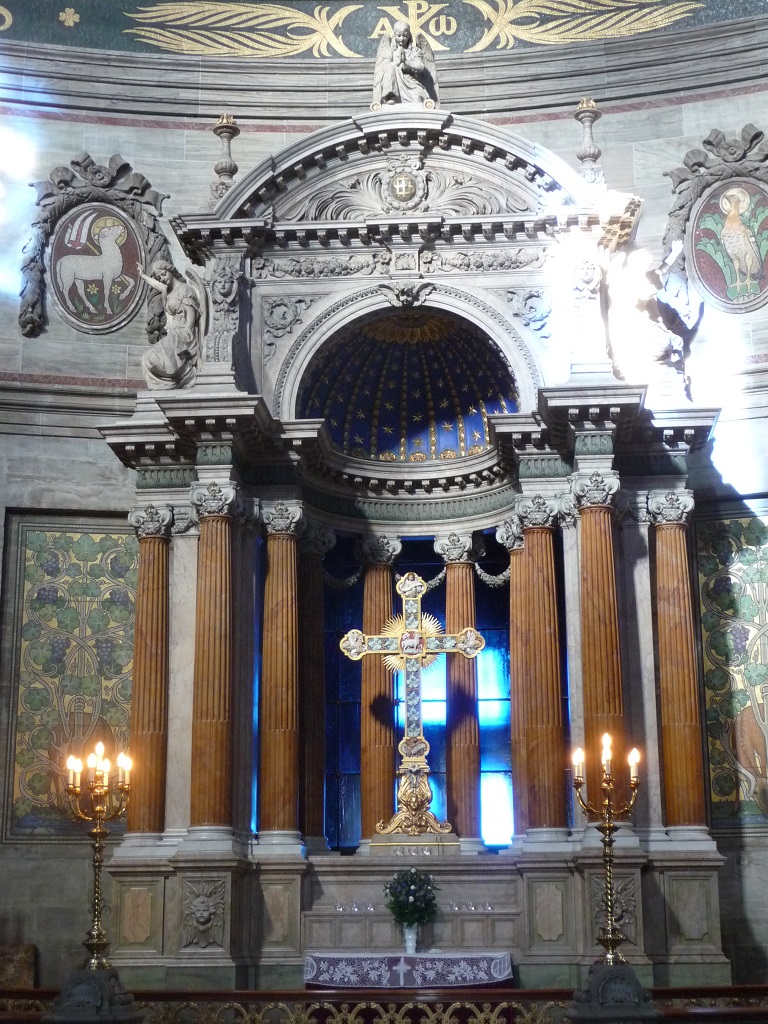 We pay a visit to the grand looking Marble Church. In Danish the church is known as the Marmorkirken and also Frederikskirken. What strikes you most on the outside is the church’s vast dome. It is suspected that the architect, Nicolai Eigtved, based his design on St. Peter’s Basilica in Rome. The church was named for Frederik V who wanted to celebrate his families’ rule in Denmark for 300 years. Construction of the church began in 1749 with the thought that the marble would be imported from Norway. However the cost of this was too great and the work was ended. A century later the work was completed using Danish marble. Visitors can climb the 260 stairs to enjoy the view of the city from the bell tower. Al and I do not climb up the bell tower. . We sit down inside the church sinking into the holy silence as we admire the many frescos by Danish artists. I give thanks for this moment in this place. Al and I agree to walk through the shopping areas of Copenhagen separately and meet up at Nyhavn for lunch.
We pay a visit to the grand looking Marble Church. In Danish the church is known as the Marmorkirken and also Frederikskirken. What strikes you most on the outside is the church’s vast dome. It is suspected that the architect, Nicolai Eigtved, based his design on St. Peter’s Basilica in Rome. The church was named for Frederik V who wanted to celebrate his families’ rule in Denmark for 300 years. Construction of the church began in 1749 with the thought that the marble would be imported from Norway. However the cost of this was too great and the work was ended. A century later the work was completed using Danish marble. Visitors can climb the 260 stairs to enjoy the view of the city from the bell tower. Al and I do not climb up the bell tower. . We sit down inside the church sinking into the holy silence as we admire the many frescos by Danish artists. I give thanks for this moment in this place. Al and I agree to walk through the shopping areas of Copenhagen separately and meet up at Nyhavn for lunch.
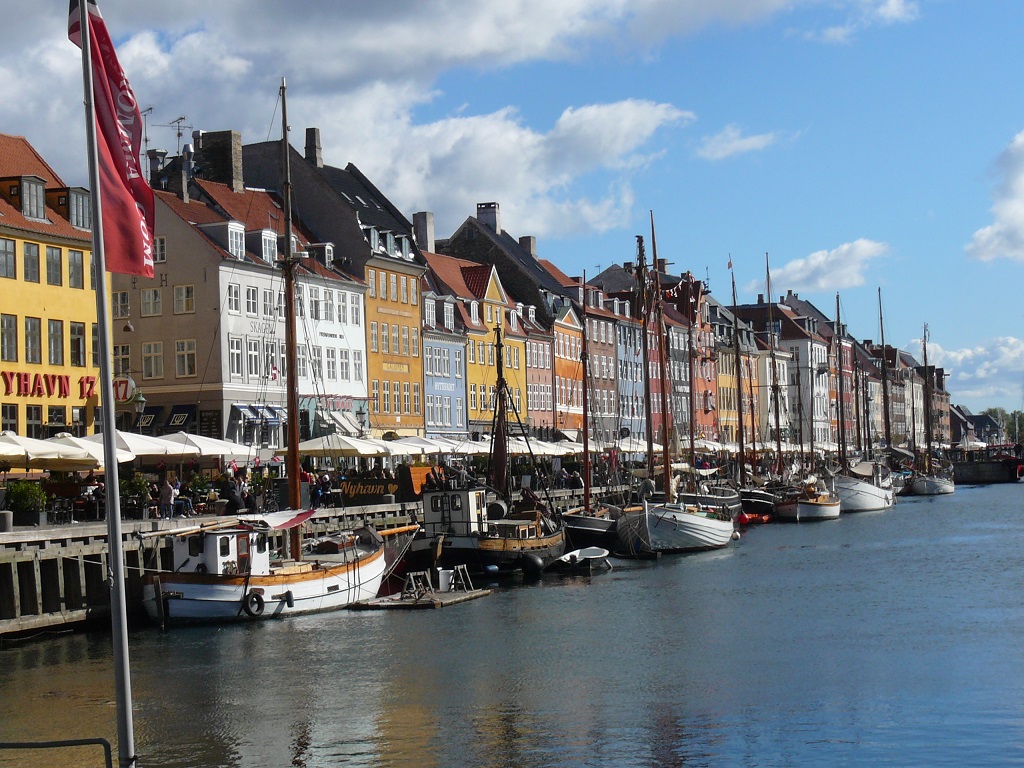
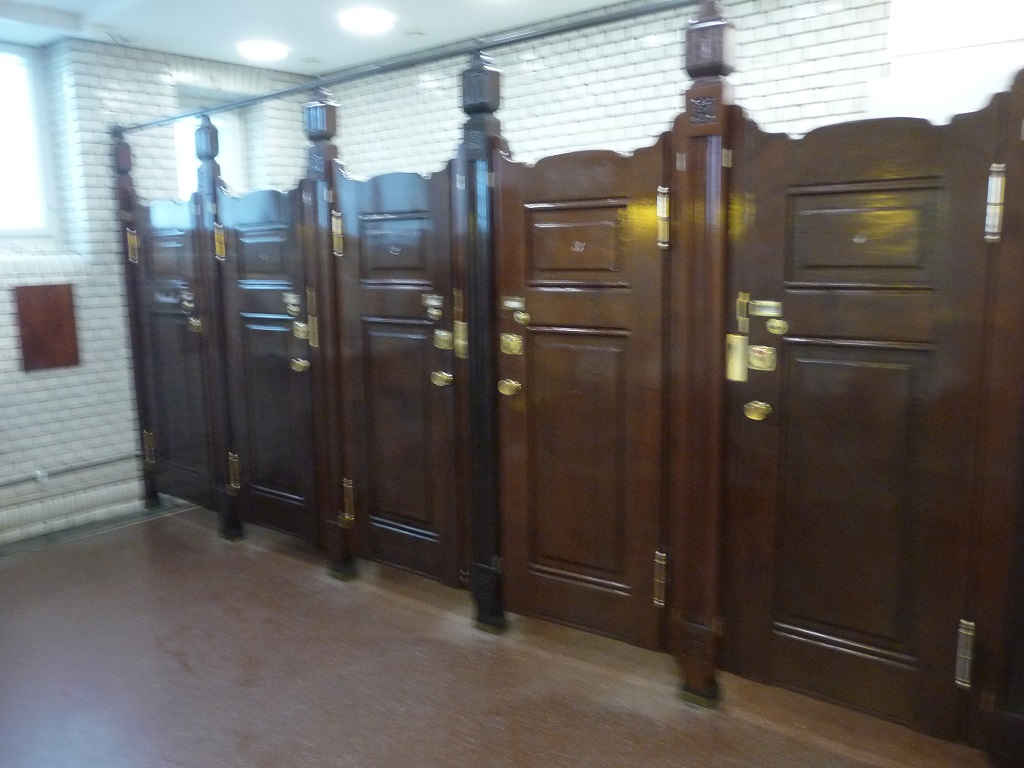 At Nyhavn we choose a cafe and sit outside near the canal. Although sunny the weather is windy and chilly and we are offered a blanket to put over us! Under the table umbrella we are also warmed by heating lights. “Did you use the public bathroom here?” Al asks me excitedly. “Did you see the doors to the stalls?!“ I’ve never seen anything like that in a bathroom. You have to see this. Go down to the ladies room and tell me if they have the same doors!” Al urges me into a lift that slowly takes me under the sidewalk to the ladies room. Sure enough. Large impressive dark wood doors stand sentry to each stall. They look like some kind of church door to me. Very unusual. For lunch Al orders a lobster soup, hummersuppe and I order a club sandwich.
At Nyhavn we choose a cafe and sit outside near the canal. Although sunny the weather is windy and chilly and we are offered a blanket to put over us! Under the table umbrella we are also warmed by heating lights. “Did you use the public bathroom here?” Al asks me excitedly. “Did you see the doors to the stalls?!“ I’ve never seen anything like that in a bathroom. You have to see this. Go down to the ladies room and tell me if they have the same doors!” Al urges me into a lift that slowly takes me under the sidewalk to the ladies room. Sure enough. Large impressive dark wood doors stand sentry to each stall. They look like some kind of church door to me. Very unusual. For lunch Al orders a lobster soup, hummersuppe and I order a club sandwich.
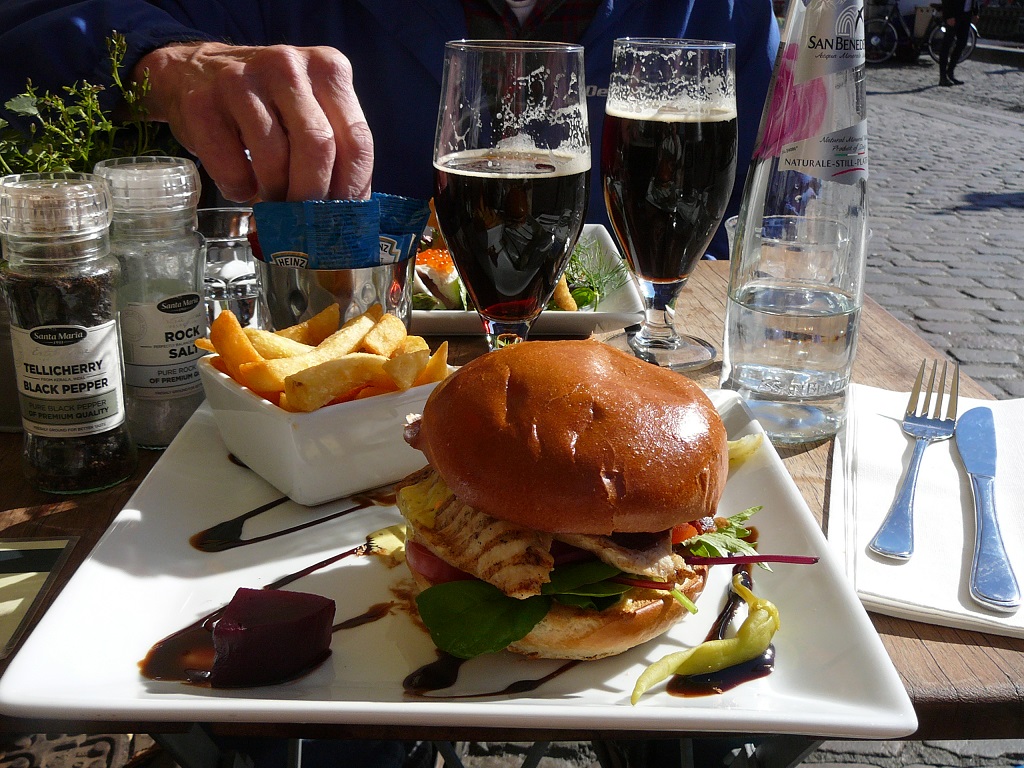 Nyhavn is full of history. The harbor was dug by soldiers between 1671 and 1673 intending to enable ships loaded with merchandise to sail into the center of Copenhagen. Today yachts are moored at many of the quays including a 19th century lightship which is now a restaurant. When Hans Christian Anderson lived here,the area was a notorious red light district full of cheap bars, hotels, tattoo parlors and numerous brothels. Now the area is far different. It is very visitor friendly and a hugely popular place to congregate. At one end of the canal a huge anchor is found that once belonged to Fyen, a 19th century frigate. The anchor is used to commemorate Danish sailors who lost their lives during WWII. Some interesting facts about Nyhavn: No. 9 house is the oldest building along the Nyhavn Canal, built in 1681. The house has not been changed since then. The architectural style of the colorful houses along the Nyhavn canal is authentic 17th century style. Hans Christian Anderson, the famous fairy tale writer, lived in three of the Nyhavn houses; no. 20, no. 67 and no. 18 over the years.
Nyhavn is full of history. The harbor was dug by soldiers between 1671 and 1673 intending to enable ships loaded with merchandise to sail into the center of Copenhagen. Today yachts are moored at many of the quays including a 19th century lightship which is now a restaurant. When Hans Christian Anderson lived here,the area was a notorious red light district full of cheap bars, hotels, tattoo parlors and numerous brothels. Now the area is far different. It is very visitor friendly and a hugely popular place to congregate. At one end of the canal a huge anchor is found that once belonged to Fyen, a 19th century frigate. The anchor is used to commemorate Danish sailors who lost their lives during WWII. Some interesting facts about Nyhavn: No. 9 house is the oldest building along the Nyhavn Canal, built in 1681. The house has not been changed since then. The architectural style of the colorful houses along the Nyhavn canal is authentic 17th century style. Hans Christian Anderson, the famous fairy tale writer, lived in three of the Nyhavn houses; no. 20, no. 67 and no. 18 over the years.
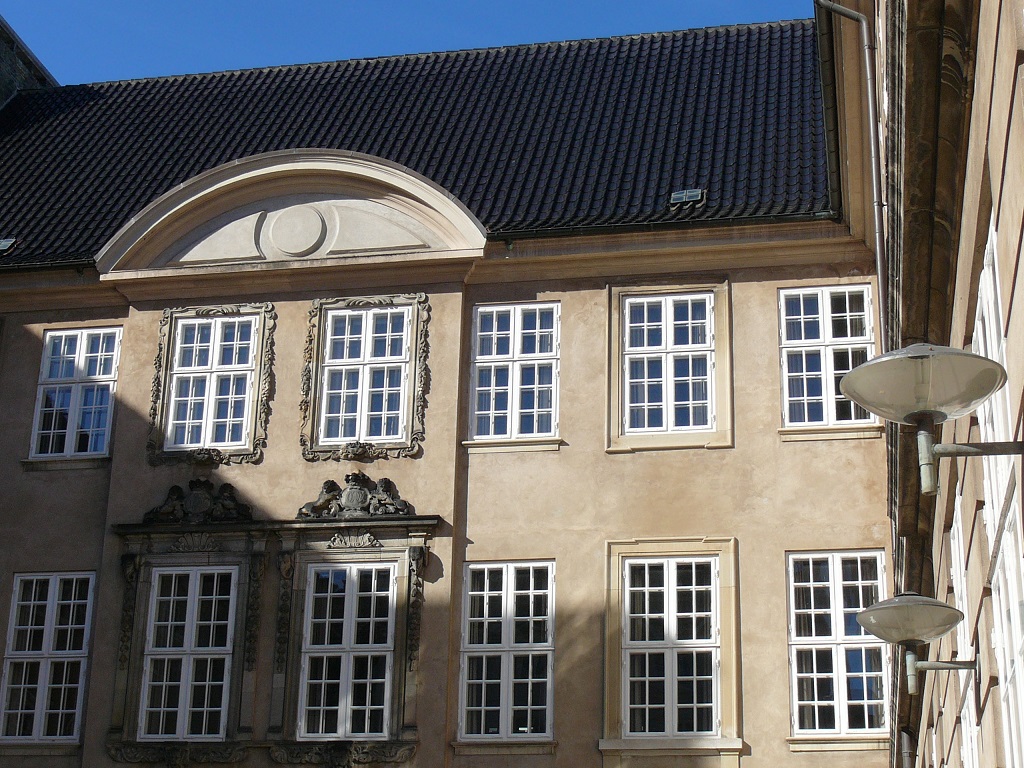
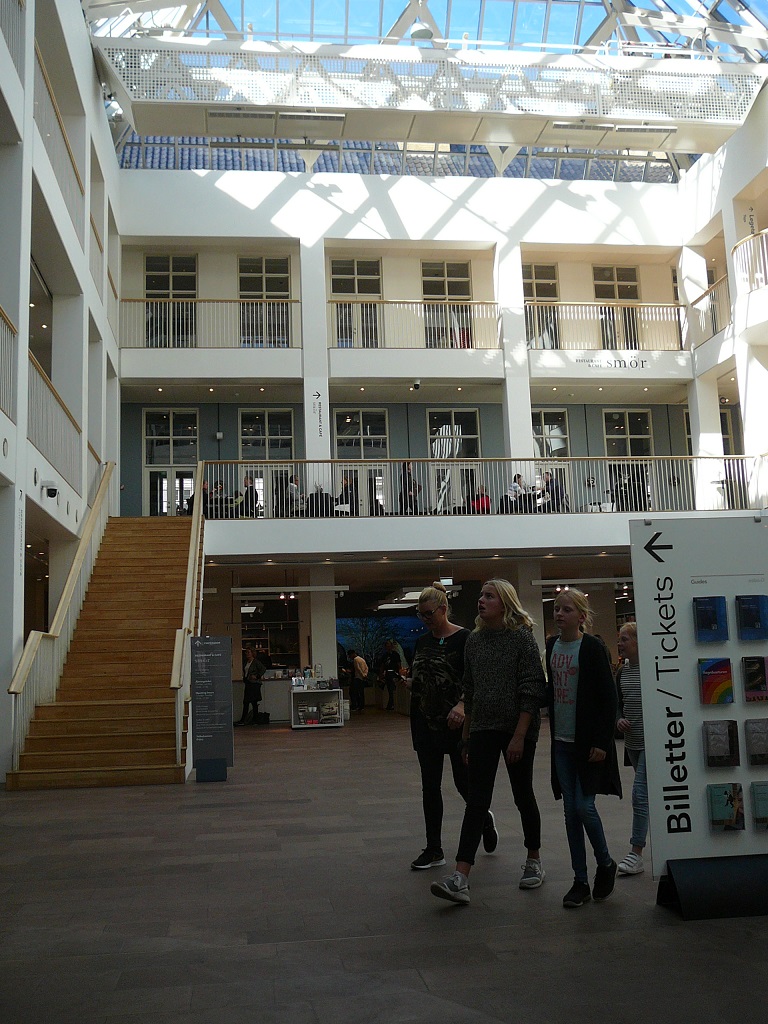 After lunch we walk many city blocks to the other side of town where we visit the National Museum. The exhibits in this old building, with modern interior work, include many items relating to Denmark’s history as well as artifacts from all over the world. Among the vast arrays on display are Inuit costumes and tools, Viking weapons, priceless Egyptian jewelry and Stone-Age tools. The children’s section is a place where kids can try on armors or “camping” in a Bedouin tent.
After lunch we walk many city blocks to the other side of town where we visit the National Museum. The exhibits in this old building, with modern interior work, include many items relating to Denmark’s history as well as artifacts from all over the world. Among the vast arrays on display are Inuit costumes and tools, Viking weapons, priceless Egyptian jewelry and Stone-Age tools. The children’s section is a place where kids can try on armors or “camping” in a Bedouin tent.

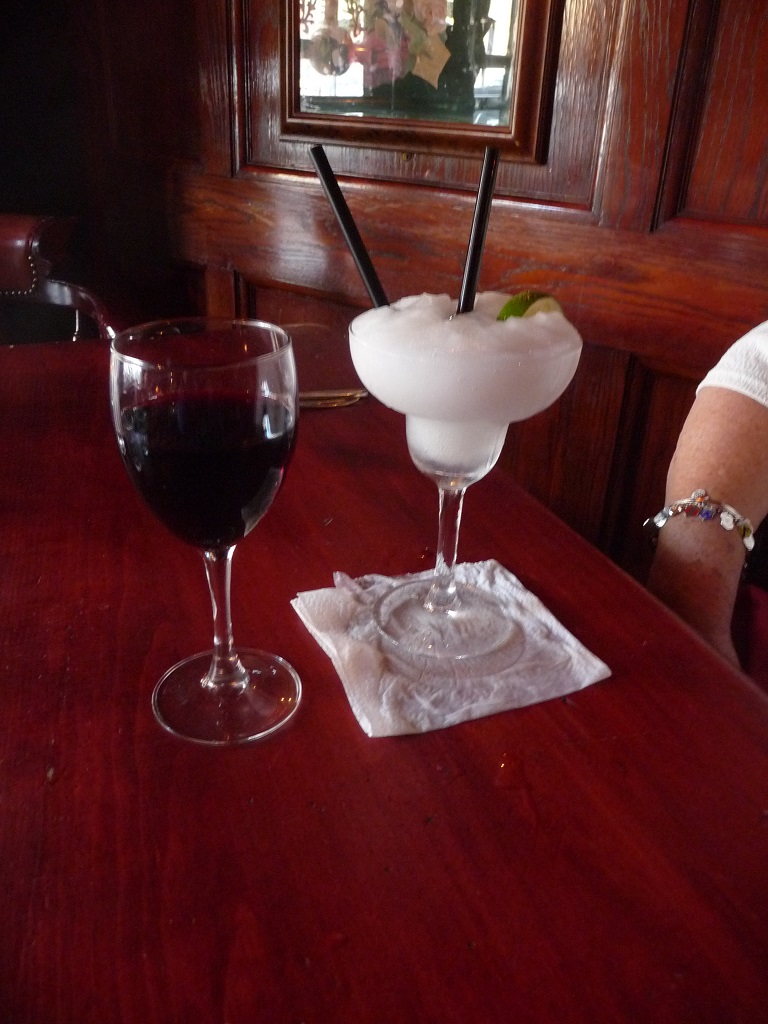 After spending a couple hours in the museum Al and I are ready for supper. We wander the area and find the Rosie McGee Pub which seems to call our names! The interior is so dark we have to stand still until our eyes adjust to the dark wood and low lighting. We peek into a room labeled as the “John Lennon Library Room” but choose a table just outside this room. We order some quesadillas as Al jokes with the waitress quipping, “I thought every food in Denmark is either smoked, pickled or marinated!” She got a good laugh out of that. We are so far from our hotel that after dinner we take a taxi back! It is the end of our 2nd and last full day in Copenhagen.
After spending a couple hours in the museum Al and I are ready for supper. We wander the area and find the Rosie McGee Pub which seems to call our names! The interior is so dark we have to stand still until our eyes adjust to the dark wood and low lighting. We peek into a room labeled as the “John Lennon Library Room” but choose a table just outside this room. We order some quesadillas as Al jokes with the waitress quipping, “I thought every food in Denmark is either smoked, pickled or marinated!” She got a good laugh out of that. We are so far from our hotel that after dinner we take a taxi back! It is the end of our 2nd and last full day in Copenhagen.

Next Day of Journey


 Oh joy of joys! Our window faces east, and the sun rises brightly and shines into our room. We will have a good day to walk the city streets. Outside our windows we gaze down on the old sailing vessels lining the inner river. After breakfast Al and I stroll up and down admiring the “Lilla Dan” of Kobenhavn, the “Halmo” of Svenborg, Denmark and the “Mira” of Kobenhavn.
Oh joy of joys! Our window faces east, and the sun rises brightly and shines into our room. We will have a good day to walk the city streets. Outside our windows we gaze down on the old sailing vessels lining the inner river. After breakfast Al and I stroll up and down admiring the “Lilla Dan” of Kobenhavn, the “Halmo” of Svenborg, Denmark and the “Mira” of Kobenhavn.









